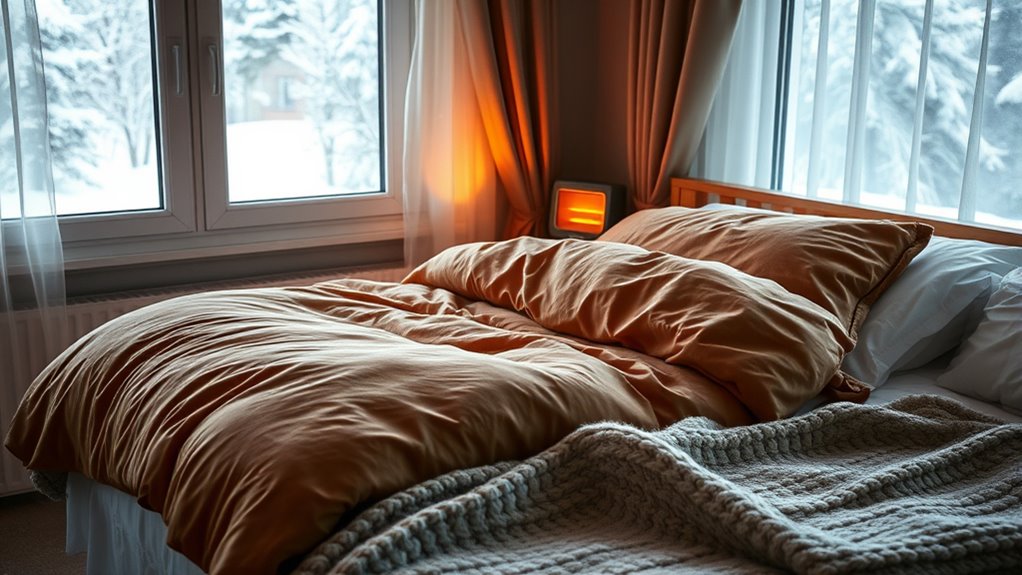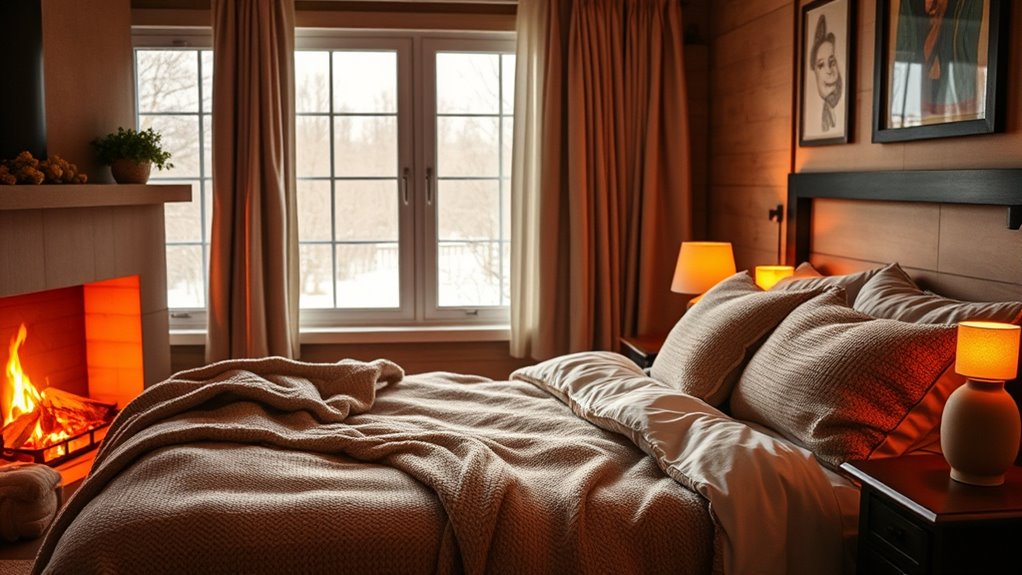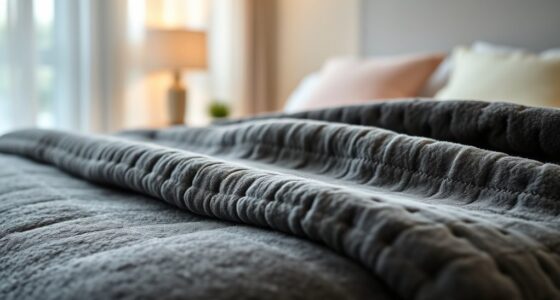To adapt your bedroom for different seasons, adjust your bedding with heavier blankets in winter and lighter sheets in summer. Manage room temperature by using heaters or fans so it stays around 60-67°F. Control lighting with blackout curtains in summer and natural light in winter. Wear breathable pajamas in summer and layered sleepwear during colder months. Making these seasonal changes can improve your sleep quality—keep exploring for more tips on creating the perfect sleep environment all year round.
Key Takeaways
- Adjust bedding with heavier blankets or lightweight sheets based on seasonal temperatures to maintain comfort.
- Modify room temperature with heaters or fans to keep it between 60-67°F year-round.
- Use blackout curtains in summer and increase natural light exposure in winter to support circadian rhythm.
- Select season-appropriate sleepwear made of breathable or insulating fabrics to regulate body temperature.
- Ensure safe use of heating or cooling devices and maintain a dark, quiet, and secure sleep environment.

As the seasons change, so do our sleep patterns, often without us even realizing it. You might find yourself tossing and turning more during the winter or feeling overly warm in the summer. One key way to adapt is by paying close attention to your sleep environment. Your bedroom temperature, lighting, and overall ambiance all influence how well you sleep, especially as weather shifts. Small adjustments can make a big difference in maintaining restful nights year-round.
Start by evaluating your bedding choices. In colder months, heavier blankets, duvets, or comforters can help trap body heat, guaranteeing you stay warm without overheating. Opt for materials like wool or flannel, which insulate effectively and wick away moisture, keeping you comfortable throughout the night. Conversely, when the weather warms up, switch to lighter bedding—such as cotton sheets or even a thin quilt—to prevent overheating. Breathable fabrics promote air circulation, helping regulate your body temperature and reducing night sweats.
Your sleep environment isn’t just about bedding. Temperature control plays an essential role. During winter, you might need to turn up your thermostat slightly or use a space heater, but be mindful of safety. In summer, consider using fans or air conditioning to keep the room cool and consistent. Consistent room temperatures—ideally between 60 and 67 degrees Fahrenheit—support better sleep, regardless of the season. Also, blackout curtains or shades can help block out early morning light or summer street illumination, creating a stable, dark environment conducive to sleep.
Lighting is another factor to consider. Longer daylight hours in summer can disrupt your internal clock, so using blackout curtains can help you maintain darkness and signal to your body that it’s time to sleep. In winter, maximizing natural light during the day can boost your mood and regulate your circadian rhythm, making it easier to wind down at night. Avoid bright screens close to bedtime, as they emit blue light that interferes with melatonin production. Additionally, understanding the importance of fire safety standards for your space can help ensure a safe environment while you rest, especially if you use heating devices during colder months.
Finally, don’t forget to adjust your clothing to match the season. Wearing breathable, moisture-wicking pajamas during summer prevents overheating, while layering with warmer sleepwear in winter ensures you stay cozy. These small changes to your sleep environment and bedding choices can profoundly improve your sleep quality as the seasons change, helping you wake up refreshed no matter the weather outside.
Frequently Asked Questions
How Can I Prevent Allergies During Seasonal Changes?
To prevent allergies during seasonal changes, you should use an air purifier to trap airborne allergens and keep your bedroom air clean. Switching to allergy-proof bedding with dust mite covers and washable covers helps reduce exposure to common allergens. Regularly vacuum and wash your bedding, curtains, and soft furnishings. Keep windows closed during high pollen seasons, and maintain low humidity to limit mold growth, all of which help minimize allergy symptoms.
What Are the Best Bedding Materials for Extreme Temperatures?
They say “you are what you sleep in,” so choose wisely. For extreme temperatures, opt for cooling fabrics like linen or bamboo to stay comfortable when it’s hot. In cold weather, insulate with cozy layers like flannel or wool, which trap heat effectively. Combining cooling fabrics and insulating layers guarantees your bedding adapts to weather changes, keeping you comfortable year-round.
How Does Daylight Exposure Affect Sleep During Different Seasons?
Daylight exposure directly influences your sleep by regulating circadian rhythms, which vary with the seasons. During longer summer days, you get more light exposure, helping you stay alert and sleep later. In winter, reduced daylight can cause earlier sleep and wake times. To maintain healthy sleep patterns, try to get natural light during the day and limit artificial light at night, supporting your circadian rhythms year-round.
Are There Specific Sleep Supplements Recommended for Seasonal Shifts?
You might find melatonin supplements helpful during seasonal shifts, as they can regulate your sleep cycle when daylight hours change. Herbal remedies like valerian root or chamomile are also popular for promoting relaxation and improving sleep quality. Studies show that about 50% of people experience improved sleep with melatonin. Always consult a healthcare professional before starting any supplements to guarantee they’re safe and appropriate for your needs.
How Can I Maintain Consistent Sleep Quality Year-Round?
To maintain consistent sleep quality year-round, focus on optimizing your sleep environment through climate control. Keep your bedroom cool in summer and warm in winter, using fans, air conditioning, or heaters as needed. Block out light and noise, and ensure your bedding suits the season. By creating a comfortable, stable sleep environment, you’ll help your body adapt naturally, improving sleep quality regardless of weather changes.
Conclusion
Remember, a good night’s sleep is like a well-tended garden—needs the right conditions to flourish. As the seasons change, adjusting your bedroom temperature and comfort can make all the difference. Don’t wait until discomfort wakes you; instead, stay ahead of the weather’s whims. Embrace these small changes now, and you’ll find restful nights become as natural as the seasons themselves—each one bringing the promise of renewal and fresh beginnings.








